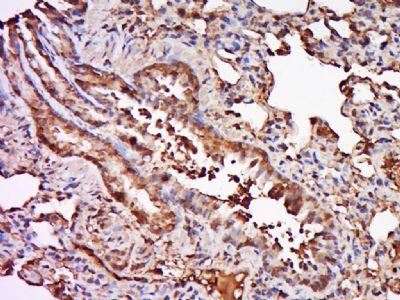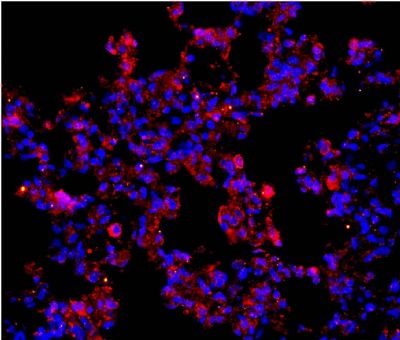产品中心
当前位置:首页>产品中心Anti-TRAF6
货号: bs-1184R 基本售价: 780.0 元 规格: 50ul
- 规格:50ul
- 价格:780.00元
- 规格:100ul
- 价格:1380.00元
- 规格:200ul
- 价格:2200.00元
产品信息
- 产品编号
- bs-1184R
- 英文名称
- TRAF6
- 中文名称
- 肿瘤坏死因子受体相关因子6抗体
- 别 名
- TNF receptor-associated factor 6; Interleukin 1 signal transducer; MGC 3310; MGC3310; RING finger protein 85; RNF 85; RNF85; TRAF 6; TRAF-6; TRAF6_HUMAN.
- 规格价格
- 50ul/780元购买 100ul/1380元购买 200ul/2200元购买 大包装/询价
- 说 明 书
- 50ul 100ul 200ul
- 研究领域
- 肿瘤 信号转导 细胞凋亡 细胞膜受体
- 抗体来源
- Rabbit
- 克隆类型
- Polyclonal
- 交叉反应
- Human, Mouse, Rat,
- 产品应用
- ELISA=1:500-1000 IHC-P=1:400-800 IHC-F=1:400-800 IF=1:100-500 (石蜡切片需做抗原修复)
not yet tested in other applications.
optimal dilutions/concentrations should be determined by the end user.
- 分 子 量
- 60kDa
- 细胞定位
- 细胞核
- 性 状
- Lyophilized or Liquid
- 浓 度
- 1mg/ml
- 免 疫 原
- KLH conjugated synthetic peptide derived from human TRAF6:441-530/530
- 亚 型
- IgG
- 纯化方法
- affinity purified by Protein A
- 储 存 液
- 0.01M TBS(pH7.4) with 1% BSA, 0.03% Proclin300 and 50% Glycerol.
- 保存条件
- Store at -20 °C for one year. Avoid repeated freeze/thaw cycles. The lyophilized antibody is stable at room temperature for at least one month and for greater than a year when kept at -20°C. When reconstituted in sterile pH 7.4 0.01M PBS or diluent of antibody the antibody is stable for at least two weeks at 2-4 °C.
- PubMed
- PubMed
- 产品介绍
- background:
The protein encoded by this gene is a member of the TNF receptor associated factor (TRAF) protein family. TRAF proteins are associated with, and mediate signal transduction from members of the TNF receptor superfamily. This protein mediates the signaling not only from the members of the TNF receptor superfamily, but also from the members of the Toll/IL-1 family. Signals from receptors such as CD40, TNFSF11/RANCE and IL-1 have been shown to be mediated by this protein. This protein also interacts with various protein kinases including IRAK1/IRAK, SRC and PKCzeta, which provides a link between distinct signaling pathways. This protein functions as a signal transducer in the NF-kappaB pathway that activates IkappaB kinase (IKK) in response to proinflammatory cytokines. The interaction of this protein with UBE2N/UBC13, and UBE2V1/UEV1A, which are ubiquitin conjugating enzymes catalyzing the formation of polyubiquitin chains, has been found to be required for IKK activation by this protein. Two alternatively spliced transcript variants encoding identical proteins have been reported. [provided by RefSeq].
Function:
E3 ubiquitin ligase that, together with UBE2N and UBE2V1, mediates the synthesis of Lys-63-linked-polyubiquitin chains conjugated to proteins, such as IKBKG, AKT1 and AKT2. Also mediates ubiquitination of free/unanchored polyubiquitin chain that leads to MAP3K7 activation. Leads to the activation of NF-kappa-B and JUN. May be essential for the formation of functional osteoclasts. Seems to also play a role in dendritic cells (DCs) maturation and/or activation. Represses c-Myb-mediated transactivation, in B-lymphocytes. Adapter protein that seems to play a role in signal transduction initiated via TNF receptor, IL-1 receptor and IL-17 receptor. Regulates osteoclast differentiation by mediating the activation of adapter protein complex 1 (AP-1) and NF-kappa-B, in response to RANK-L stimulation.
Subunit:
Homotrimer. Homooligomer. N-terminal region is dimeric while C-terminal region is trimeric; maybe providing a mode of oligomerization. Upon IL1B treatment, forms a complex with PELI1, IRAK1, IRAK4 and MYD88; this complex recruits MAP3K7/TAK1, TAB1 and TAB2 to mediate NF-kappa-B activation. Direct binding of SMAD6 to PELI1 prevents the complex formation and hence negatively regulates IL1R-TLR signaling and eventually NF-kappa-B-mediated gene expression. Binds to TNFRSF5/CD40 and TNFRSF11A/RANK. Associates with NGFR, TNFRSF17, IRAK2, IRAK3, RIPK2, MAP3K1, MAP3K5, MAP3K14, CSK, TRAF, TRAF-interacting protein TRIP and TNF receptor associated protein TDP2. Interacts with IL17R. Interacts with SQSTM1 bridging NTRK1 and NGFR. Forms a ternary complex with SQSTM1 and PRKCZ (By similarity). Interacts with PELI2 and PELI3. Binds UBE2V1. Interacts with MAVS/IPS1. Interacts with TAX1BP1. Interacts with IL1RL1. Interacts with TRAFD1. Interacts with ZNF675. Interacts with AJUBA. Interacts with TICAM1 and TICAM2. Interacts with ZFAND5. Interacts with ARRB1 and ARRB2. Interacts with MAP3K7 and TAB1/MAP3K7IP1; during IL-1 signaling. Interacts with UBE2N. Interacts with TGFBR1, HDAC1 and RANGAP1. Interacts with AKT1, AKT2 and AKT3. Interacts (via TRAF domains) with NUMBL (via C-terminal). Interacts (via TRAF domains) with WDR34 (via WD domains). Interacts with RBCK1. Interacts with TRAF3IP2. Interacts with LIMD1 (via LIM domains) (By similarity). Interacts with RSAD2/viperin (By similarity). Interacts with IFIT3 (via N-terminus). Interacts (via C-terminus) with EIF2AK2/PKR (via the kinase catalytic domain) (By similarity).
Subcellular Location:
Cytoplasm. Cytoplasm, cell cortex. Nucleus. Lipid droplet (By similarity). Note=Found in the nuclei of some agressive B-cell lymphoma cell lines as well as in the nuclei of both resting and activated T- and B-lymphocytes. Found in punctate nuclear body protein complexes. Ubiquitination may occur in the cytoplasm and sumoylation in the nucleus. RSAD2/viperin recruits it to the lipid droplet (By similarity).
Tissue Specificity:
Expressed in heart, brain, placenta, lung, liver, skeletal muscle, kidney and pancreas.
Post-translational modifications:
Sumoylated on Lys-124, Lys-142 and Lys-453 with SUMO1.
Polyubiquitinated on Lys-124; after cell stimulation with IL-1-beta or TGF-beta. This ligand-induced cell stimulation leads to dimerization/oligomerization of TRAF6 molecules, followed by auto-ubiquitination which involves UBE2N and UBE2V1 and leads to TRAF6 activation. This Lys-63 site-specific poly-ubiquitination appears to be associated with the activation of signaling molecules. Endogenous autoubiquitination occurs only for the cytoplasmic form.
Similarity:
Belongs to the TNF receptor-associated factor family. A subfamily.
Contains 1 MATH domain.
Contains 1 RING-type zinc finger.
Contains 2 TRAF-type zinc fingers.
SWISS:
P70196
Gene ID:
7189
Database links:Entrez Gene: 7189 Human
Entrez Gene: 22034 Mouse
Entrez Gene: 311245 Rat
Omim: 602355 Human
SwissProt: Q9Y4K3 Human
SwissProt: P70196 Mouse
SwissProt: B5DF45 Rat
Unigene: 591983 Human
Unigene: 292729 Mouse
Unigene: 220435 Rat
Important Note:
This product as supplied is intended for research use only, not for use in human, therapeutic or diagnostic applications.
TRAF6是TRAF家族中最新的成员,是NF-kappaB通路的一种信号转导子,TRAF6分布较广泛,在脑、肺、肝、骨骼肌及肾脏分布较高,在心脏、脾脏和睾丸也有表达。
- 产品图片
 Tissue/cell: Rat lung tissue; 4% Paraformaldehyde-fixed and paraffin-embedded;
Tissue/cell: Rat lung tissue; 4% Paraformaldehyde-fixed and paraffin-embedded;
Antigen retrieval: citrate buffer ( 0.01M, pH 6.0 ), Boiling bathing for 15min; Block endogenous peroxidase by 3% Hydrogen peroxide for 30min; Blocking buffer (normal goat serum,C-0005) at 37℃ for 20 min;
Incubation: Anti-TRAF6 Polyclonal Antibody, Unconjugated(bs-1184R) 1:500, overnight at 4°C, followed by conjugation to the secondary antibody(SP-0023) and DAB(C-0010) staining Tissue/cell: Mouse lung tissue;4% Paraformaldehyde-fixed and paraffin-embedded;
Tissue/cell: Mouse lung tissue;4% Paraformaldehyde-fixed and paraffin-embedded;
Antigen retrieval: citrate buffer ( 0.01M, pH 6.0 ), Boiling bathing for 15min; Blocking buffer (normal goat serum,C-0005) at 37℃ for 20 min;
Incubation: Anti-TRAF6 Polyclonal Antibody, Unconjugated(bs-1184R) 1:200, overnight at 4°C; The secondary antibody was Goat Anti-Rabbit IgG, Cy3 conjugated(bs-0295G-Cy3)used at 1:200 dilution for 40 minutes at 37°C. DAPI(5ug/ml,blue,C-0033) was used to stain the cell nuclei

